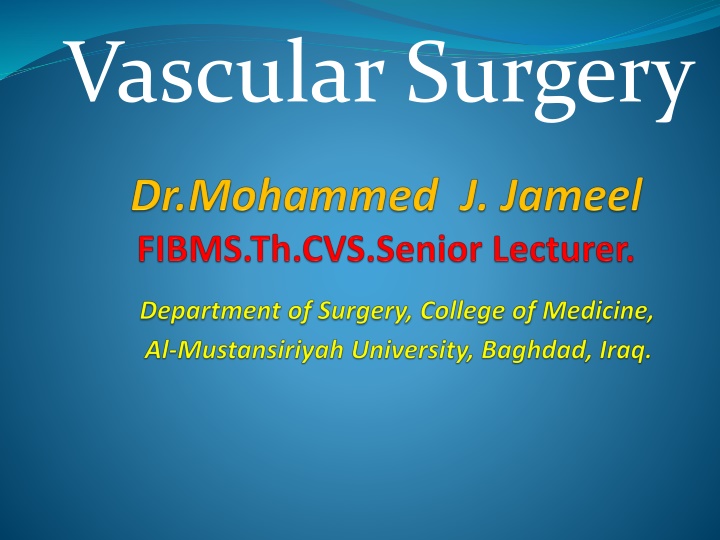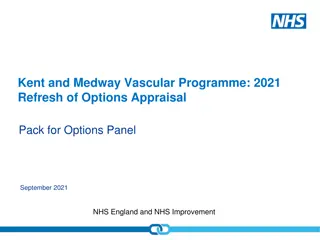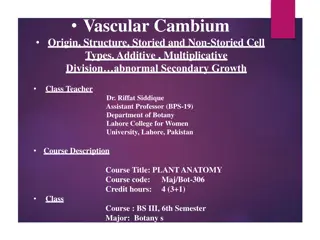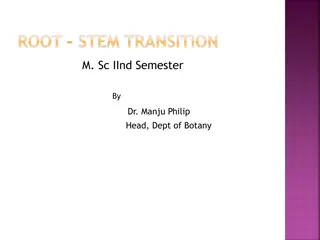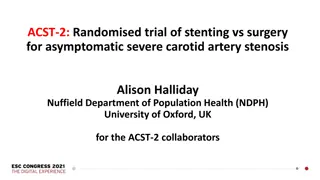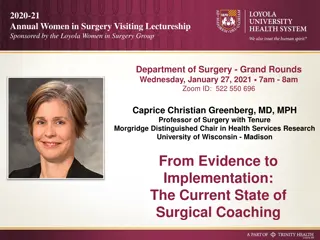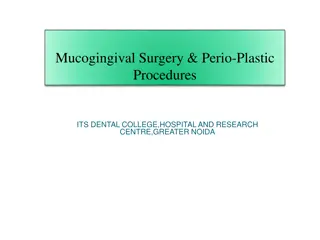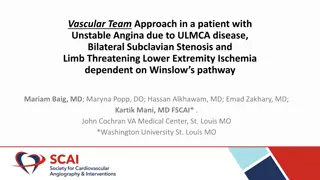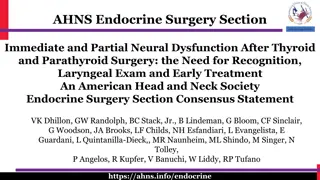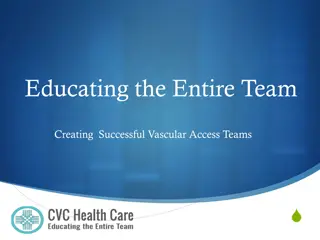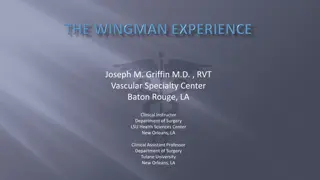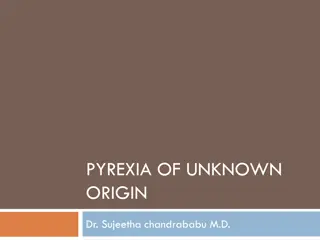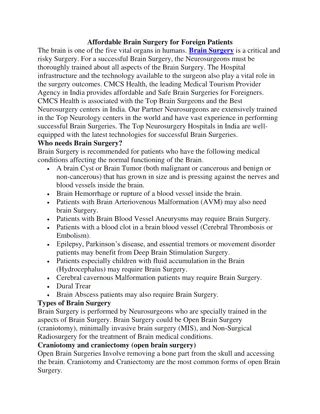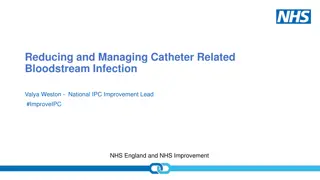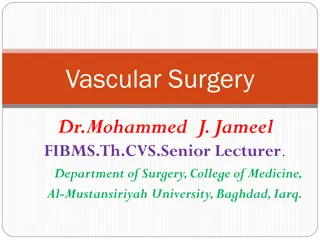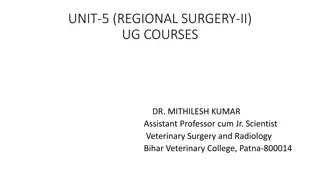Vascular Surgery: Aneurysm Classification and Management
A detailed overview of vascular surgery focusing on aneurysm types, classifications, symptoms, diagnostic procedures, surgical interventions, and postoperative care. Learn about abdominal aortic aneurysm, operative methods, and endoluminal prosthesis options.
Download Presentation

Please find below an Image/Link to download the presentation.
The content on the website is provided AS IS for your information and personal use only. It may not be sold, licensed, or shared on other websites without obtaining consent from the author.If you encounter any issues during the download, it is possible that the publisher has removed the file from their server.
You are allowed to download the files provided on this website for personal or commercial use, subject to the condition that they are used lawfully. All files are the property of their respective owners.
The content on the website is provided AS IS for your information and personal use only. It may not be sold, licensed, or shared on other websites without obtaining consent from the author.
E N D
Presentation Transcript
Lec: 2 Aneurysm :- means dilatation of localized segment of the arterial system, classified :- 1. according to wall thickness a. True An. :-contain the 3 layers of the arterial wall (intima ,media ,adventitia ) in the wall of An. Sac. b. False An. :- in which single layer of fibrous tissue form the wall of An. Sac e.g. Traumatic An. 2. according to Shape :- a.Fusiform 3. according to Etiology :- a. Atheromatus c.Infective d.Traumatic An. Can occur any where in the major vessels , the majority are true , fusiform and atheromatus. C.F :- Symptoms are related to :- 1.vessel affected 2. Tissue or organ which the artery supply. Symptoms occur due to :- 1.Expansion 2.Thrombosis 3.rupture 4.Embolization. O/E :- Significant size An. Can be felt as an expensile pulsation. b. Saccular c. Dissecting. b. Collagenous
Abdominal Aortic Aneurysm:- Is the most common type of large vessel An.,it mostly involve the Aorta below Renal arteries. It may be presented as :- Ruptured An. :- rupture occur 80% anteriorly leading to free bleeding into peritoneal cavity , it associate with high mortality. 20% rupture occur posterolateral into retroperitoneal space and produce Retroperitoneal hematoma , here hypotension and resistance of retroperitoneal space will arrest bleeding. Overall 60% of pt.s die at onset of rupture while 40% can reach hospital. C .Fs :- Pt. present with severe abdominal and/or back pain , shock Dx:- tender pulsatile mass is palpaple in abdominal of hypotensive pt. , dx is done on clinical findings and must be rapid and there is no time for imaging study. Mx :- must be quick 1. insert 2 I.V lines one of them must be inserted at large centeral vein. 2. start I.V fluid to keep SBP about 100 mmHg to keep cardiac perfusion and prevent rebleeding 3. Rapid transet to operative room for surgery with 6 pints blood preparation.
2. Symtomatic An. :A. Pt. present with abdominal and/or back pain. B. Pressure of An. On adjacent structure produce compression symtoms on GIT , urinary system , Lower limb nerves and venous system. In symtomatic Pt.s surgery indicated regardless to size of An. Since 80% will die with in 1 year if they are not operated. Asymtomatic An. :- found incidentally on examination or during radiological assessment , surgery is indicated in :- 1. :- An > 55mm in anteroposteriordiameter and the Pt. must be fit for surgery. Investigation :- 1.complete blood picture , Liver function tests , coagulation studies , Lipid profile , renal FTs 2. prepare fresh blood 3.assess cardiorepiratory function by ECG , Echo , Pulmonary FTs 4. CT scan abdomenthesize of An. As the conventional angiocannot show the real diameter of An. As it is filled with clots which leads to false narrow angioappearance
Operative method :- 1. Under G.A , pt. is supine , full mid-line abdominal incision , small intestine lifted to the right , posterior peritoneum opened 2. upper and lower limits of An. Identified , I.V heparin given , and cross clamp put above and below An. Sac , An. Opened and clots evacuated. 3.prosthetic graft is sutuered end to end to the Aorta inside the An.sac which is closed over the graft later , clamps released slowly. Endoluminal prosthesis :- suitable for elderly pt. who are unfit supermajorsurgery. 1. Both common femoral arteries are exposed surgically under screen control. 2.delivary system guided up into Aorta and endovascular prosthesis placed within Aortic sac to ensure firm attachment to vessel above and below An. Sac.
Popliteal artery An.:- represent 70% of peripheral An. , 65% are bilateral , 35% associate with abdominal An. , pt. present with swelling behind knee , distal ischemia may occur due tothrombosis or distal embolization. Dx :- by Dopplar study , CT angio Surgery indicted for :- 1.symtomatic An. 2.Asymtomatic An.> 25mm in diameter. Methods of surgery :- 1. Resect and put inlay graft. 2.ligate An. Proximally and distally and put bypass graft.
Arterio-Venous Fistula(AVF) :- means communication between artery and vein which may be 1.Congenital 2.Traumatic 3.Iatrogenic AVF for hemodialysis , AVF leads to :- 1.structural effect :- when arterial blood flow to vein , the vein wall will become arterialized i.edilated , tortuous , thick wall 2.physiological effect:-if AVF is big enough it will increase cardiac outputwhich may leads to LV enlargement and heart failure. O/E :- 1.pulsatile swelling when the lesion is superficial. 2. thrill on palpation 3.dilated veins 4. Buzzing continous bruit( machinery murmur) on auscultation 5. compressing of artery proximal to fistula will decrease swelling and bruit Dx :- by dopplar , angiography. Mx :- 1.Embolisation of the site of AV communication for congenital AVF since it has multiple communication. 2.for Traumatic AVF excision of the AV communication and arterial continuity established byinterposition graft. 3.for Iatrogenic AVF quadruple ligation of artery and vein proximal and distal to AVF.
Thromboangitis Obliterans (Burger disease):- Characterized by segmental occlusion of medium size arteries , mostly involve leg but forearm also may be involved , it may be associated with thrombophlibitisof superficial or deep deepveins and Raynauds syndrome , it occur in male , smoker , age < 30 yr. Histologically- there is segmental inflammatory changes in the wall of the artery with thrombotic obstruction which is hard and white in color and the arterial wall in between the involved segment is normal. Rx :- 1. Stop smoking completely 2.Asprin 3.arterial dilator e.g deltiazim . 4.Sympathectomy , arterial bypass procedure are of little value.
Gangrene :- death of macroscopic part of tissue usually affect distal part of limb duetoarterial obstruction , usually of 2 kinds 1.Dry Gan. :- develop due to gradual slowing of blood flowfrom atherosecleroticdisease , the affected part become dry and wrinkled with black discolorationdue to Hbdisentigration and greasy to touch. 2. Moist Gan. :- occur when infection and putrefaction are present , the affected part become swallon and discolored and epidermis may be raised in blebs , creptus may be present due to gas forming micro- organism. Seperation of gangrene :- demarcation zone develop between viable and dead part as a layer of granulation tissue , the line of separation will be more proximal in moist Gan. Than in dry Gan. , therefore ; dry Gan. Must be kept dry and attempt made to convert moist Gan. To dry . Rx :- 1.improve blood supply of proximal part to make amputation as distal as possible 2.keep the affected part dry and exposed to air. 3.use air beds to avoid local pressuerarea 4.remove hard desiccated skin helps demarcation , release of pus and relieve of pain.
